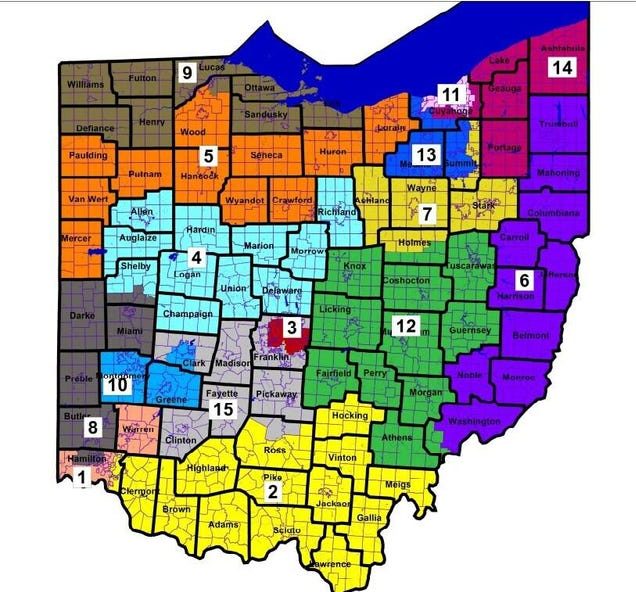Oberlin Redistricted for Congressman Bob Latta
Governor Mike DeWine signed a new congressional district map into law on Nov. 20, after months of partisan debate and multiple lawsuits. The new map has already received criticism from Democrats and pro-democracy groups for being passed on party lines. The new map moves Oberlin out of Jim Jordan’s Ohio 4th District and into the Ohio 5th District, a seat currently held by the Republican Congressman Bob Latta.
The previous map, originally adopted in 2012, was characterized by critics as an example of partisan gerrymandering. In response, nearly 75 percent of Ohioans voted in a 2018 ballot measure, Ohio Issue 1, that requires congressional maps receive bipartisan support in order to be passed. If the map fails to do so, it must be redrawn after four years rather than the standard 10.
“This [new map] is going to be even worse,” said Janet Garrett, former Democratic candidate for the Ohio 4th District in 2014, 2016, and 2018. “It’s going to be more like 80 percent Republican. The really disgusting thing about this is that the Republicans want to win by dirty tricks rather than by appealing to the population to get their support for their positions. The more gerrymandered the districts are, the more extreme candidates we’re going to end up getting.”
Nonetheless, Republicans praised the map for keeping several of the state’s largest cities contained in one district. The new map also means there are now two competitive seats in the state, compared to only one previously.
“It’s actually an improvement over what was done 10 years ago,” said Executive Chairman of the Lorain County Republican Party David Arredondo. “If you were to look at district lines today and the new ones you’ll see a vast improvement. So we got whacked for what we did 10 years ago with good reason. Okay, fine. We don’t need that kind of distortion of districts, … so my answer to the folks who are challenging [the map] is, number one, if the Democrats were doing it, they do it to their benefit; number two, that we have considerations such as the Voting Rights Act that we can’t be splitting Black communities and depriving them of the opportunity of electing gay, Black representatives.”
However, Democrats argue that the map is more problematic than the one passed a decade ago. Since Ohio lost a congressional seat in the reapportionment process that occurred after the last census, Ohio Democratic Representative Tim Ryan’s seat is eliminated in the new map. Democrat Marcy Kaptur’s district is also broken up into several heavily Republican-leaning districts.
The new map also received criticism for dividing predominantly Black communities in Ohio into different districts, diluting these communities’ voices with white voters. For example, voters in Hamilton County, home to Cincinnati, were divided into three districts.
“One of the things you’re supposed to do when you redistrict is you’re supposed to take into account communities of interest and make sure that you’re doing the best you can of not dividing them,” said Jenny Garcia, assistant professor of Politics and Comparative American Studies. “And one pushback I’ve heard is that there are some districts that include Appalachian counties and others. They’re combining them with more urban areas and it’s hard to see commonalities there between them. So the ideal is when you have a representative who can represent a fairly coherent district.”
There are already several lawsuits in response to the new map. Former U.S. Attorney General Eric Holder Jr. and the National Redistricting Action Fund are suing in the Ohio Supreme Court. The American Civil Liberties Union, League of Women Voters of Ohio, and the A. Philip Randolph Institute have also filed a lawsuit saying the map violates the Ohio Issue 1 amendment that voters passed three years ago.
“The Ohio Supreme Court is made up of five justices,” Garrett said. “One of them is the son of Mike DeWine. Some people have called for him to recuse himself, but of course, nobody can make him, so he’s not recusing himself. The chief justice is a Republican — however, she tends to not be in favor of these gerrymandering shenanigans. So there are some people who are saying there’s some hope out at the Supreme Court, but we’ll see.”
The lawsuits come after conflicts over proposed maps escalated over the last few months. After failing to pass a map in the Ohio Legislature with a supermajority by Sept. 30, responsibility for drawing the map was left to the bipartisan seven-member Ohio Redistricting Commission, which also failed to meet its Oct. 31 deadline. After that, what had been a relatively slow process was then sped through the Ohio legislature along party lines in a matter of days before it was signed by DeWine at the end of November. This new map received an F grade from the nonpartisan Princeton Gerrymandering Project.
The change means that Oberlin will now likely be represented by Republican Bob Latta, who has held the seat since 2007. While Latta is a conservative member of Congress, he is not nearly as extreme as Jordan. According to Garcia, Latta is considered more conservative than 52 percent of the GOP in Congress, while Jordan, who is more conservative than 91 percent of the GOP.
For the City of Oberlin, the new map marks a significant shift from the last four years. Oberlin was previously represented by Jordan, who is known as one of the creators of the House Freedom Caucus. For the last several elections, many Oberlin students have worked on the campaigns of Jordan’s opponents, including Garrett’s and Shannon Freshour’s. This election cycle, Jeffrey Sites, a veteran and warehouse manager who ran in the Democratic primary in 2020, is once again running against Jordan.
Sites is running on a platform of single-payer healthcare, returning the supply chain to the United States, and addressing what he calls “climate chaos.” Although he started his campaign in January, before the new districts were drawn, his city, Lima, is still in the Ohio 4th District, so he will still be eligible to run against Jordan.
“It was an uphill battle before; it’s an extreme uphill battle now,” Sites said. “I would have preferred to keep the duck than what we have now. But again, I didn’t decide to run against Jim Jordan because I thought it would be easy. … We’ve planned and prepared for a district like this since the beginning. … It’s why we emphasized building a grassroots operation.”
Besides congressional races, Ohio will have several other competitive races in the 2022 midterms. Governor DeWine is up for reelection but will first face several Republican challengers. Senator Rob Portman has also announced his retirement, which has opened his seat up for a competitive race.
If the current map withstands the court battles, the map will be redrawn for the 2026 elections. While Garrett and others are disappointed with the new map, she hopes that grassroots activism will ensure that the next map is fairer.
“We have to keep the pressure on … because we’re in a very dangerous place in history right now,” Garrett said. “We’re in danger of losing our democracy, and it’s a lot easier to fight to keep it than it is to try to get it back once we’ve lost it.”







